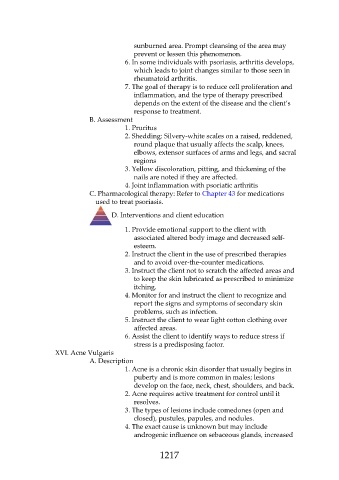Page 1217 - Saunders Comprehensive Review For NCLEX-RN
P. 1217
sunburned area. Prompt cleansing of the area may
prevent or lessen this phenomenon.
6. In some individuals with psoriasis, arthritis develops,
which leads to joint changes similar to those seen in
rheumatoid arthritis.
7. The goal of therapy is to reduce cell proliferation and
inflammation, and the type of therapy prescribed
depends on the extent of the disease and the client’s
response to treatment.
B. Assessment
1. Pruritus
2. Shedding: Silvery-white scales on a raised, reddened,
round plaque that usually affects the scalp, knees,
elbows, extensor surfaces of arms and legs, and sacral
regions
3. Yellow discoloration, pitting, and thickening of the
nails are noted if they are affected.
4. Joint inflammation with psoriatic arthritis
C. Pharmacological therapy: Refer to Chapter 43 for medications
used to treat psoriasis.
D. Interventions and client education
1. Provide emotional support to the client with
associated altered body image and decreased self-
esteem.
2. Instruct the client in the use of prescribed therapies
and to avoid over-the-counter medications.
3. Instruct the client not to scratch the affected areas and
to keep the skin lubricated as prescribed to minimize
itching.
4. Monitor for and instruct the client to recognize and
report the signs and symptoms of secondary skin
problems, such as infection.
5. Instruct the client to wear light cotton clothing over
affected areas.
6. Assist the client to identify ways to reduce stress if
stress is a predisposing factor.
XVI. Acne Vulgaris
A. Description
1. Acne is a chronic skin disorder that usually begins in
puberty and is more common in males; lesions
develop on the face, neck, chest, shoulders, and back.
2. Acne requires active treatment for control until it
resolves.
3. The types of lesions include comedones (open and
closed), pustules, papules, and nodules.
4. The exact cause is unknown but may include
androgenic influence on sebaceous glands, increased
1217

